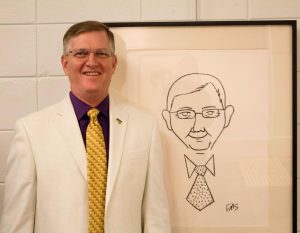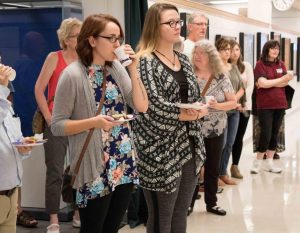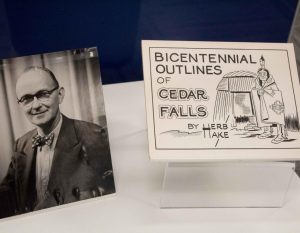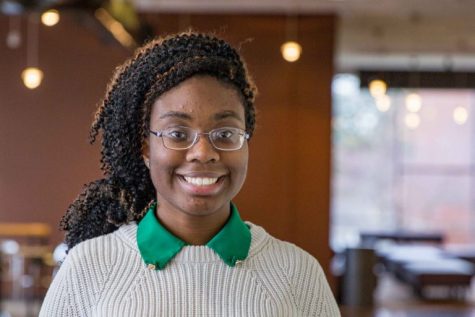UNI Museum Herb Hake exhibit
Sep 28, 2017
The UNI Museum at Rod Library opened its Right Side Up: The Life and Art of Herb Hake exhibit on Sunday, Sept. 24. Herb Hake’s artwork, radio broadcasts and television episodes were displayed, and personal stories from his former colleagues were shared.
Nathan Arndt, the assistant director and chief curator at the UNI Museum explained how Herb Hake came up during a discussion between the UNI Museum and the Cedar Falls Author Festival. According to Arndt, Hake is credited with five books but also contributed artwork and writing to numerous others.
“[I was] thinking about people at UNI that made a difference, and one of the most overlooked ones—I feel—was Herb Hake,” Arndt said.
When Arndt suggested a Hake exhibit, the library quickly got behind the idea.
According to Arndt, Hake is often remembered for his broadcast work. Hake was a radio pioneer, known for “Behind the Headlines” and “Landmarks in Iowa History.”
But, as the exhibit shows, Hake was also an artist. Piece after piece displays Hake’s unique caricature spin on influential leaders.
Half of the exhibit focused on Iowa history. Among these is a drawing of Iowa’s first governor, Ansel Briggs, depicted as the back of a head.
The other half of the art exhibit focused on Cedar Falls, including UNI presidents. Presidents James C. Gilchrist, James W. Maucker, Homer H. Seerley, John J. Kamerick, Malcolm P. Price and Orval R. Latham were displayed. UNI’s current president Mark Nook was drawn by UNI senior Emily Schroeder, who attempted to imitate Hake’s style.
Nook could also be found in-person at the exhibit opening and even offered a few words.
“The other thing that I’m very impressed about this particular display [. . .] is that Herb’s one of those people who was clearly a thought leader and helped move thought along,” Nook said. “But he didn’t hold a leadership position, a leadership title.”
Doug Vernier, who worked under Hake at UNI while Hake was doing “Behind the Headlines,” was the first keynote speaker. According to Vernier, the lasting impression of Hake prompted him to nominate Hake for inclusion in the Iowa Broadcaster’s Hall of Fall.
“What better person with all of his work [. . .] with the films, with the chalk talks, with his radio [to be nominated]?’ He’s been a broadcaster that’s really been a part of Iowa’s history and he’s the perfect person,” Vernier said.
After Hake was inducted into the hall of fame, Vernier said he got a call from Herb Hake.
“[Hake] said, ‘I’d like to draw you’,” Vernier explained. “I think it was Herb’s way of saying ‘Thank you very much for doing this’ . . . [The drawing] was a wonderful ‘thank you’ that I appreciate to this very day.”
The drawing of Vernier was displayed at the exhibit.
Carl Jenkins, who was Hake’s assistant as a student, was the second speaker. Jenkins raved about Hake’s abilities in storytelling, broadcasting, drawing, and interviewing.
“[Look] around the exhibit, listen to some of the radio,” Jenkins said. “Watch Herb at work, making history come alive and just celebrate the fact that [. . .] Herb tried to get us in the business of educating people without it being painful. I think that’s a good thing to do.”
Hake’s impact has carried onto the next generation, including Ellie Akers, a UNI senior majoring in anthropology and double-minoring in art history and chemistry. She is the research assistant and conservation research assistant at the UNI Museum, and she devoted a large part of her time to the exhibit.
Despite working on the exhibit all summer, Akers said she has yet to have her fill of Hake and his work.
“There’s just so many stories of Iowa history—how did [Hake] decide or discern what [he] wanted for a piece?” Akers said. “How [did he] start making a piece and then find out later that there’s another image there entirely? I just wanna know his processes. I wanna pick apart his brain, basically.”
UNI Museum Intern Nick Lewis, a senior studying anthropology, also worked heavily on the display.
“The one thing I did take from both [speakers] was that . . . [Hake] was more than just a mentor; he was very much a friend,” Lewis said. “And he tried his best to include [Vernier and Jenkins] in what he did and how he exemplified the standards of UNI.”
The Herb Hake exhibit will run through July 29, 2018.
“[One] of the important things about a museum — whether it’s a university museum or a natural history museum, whatever it is — it’s a way of preserving a little bit of the soul of a person,” Nook said.














